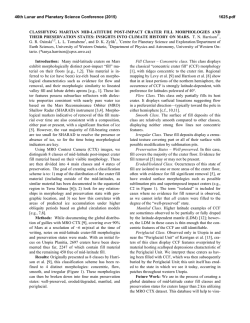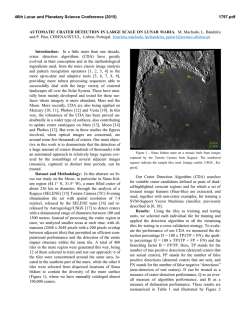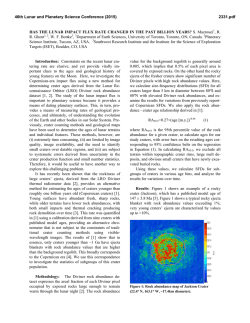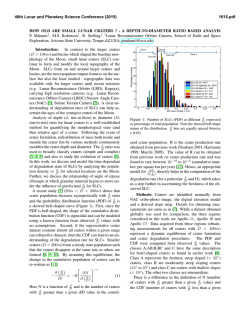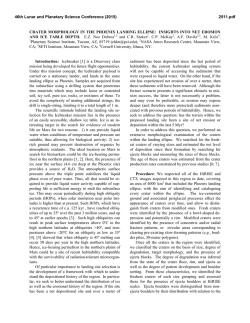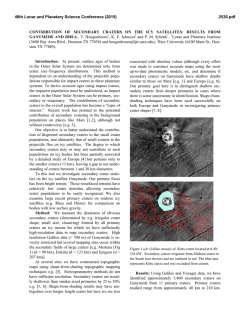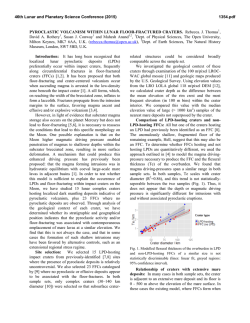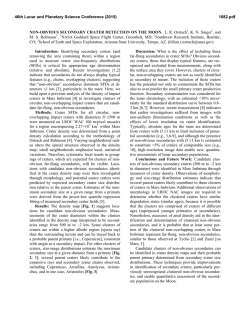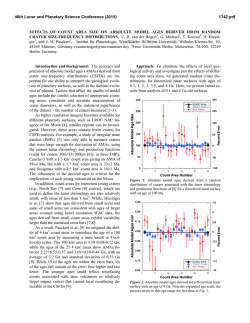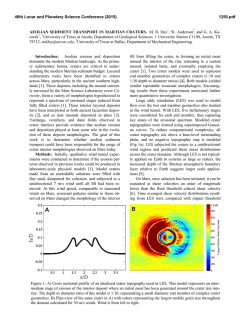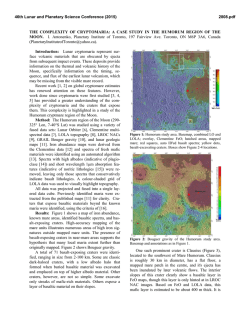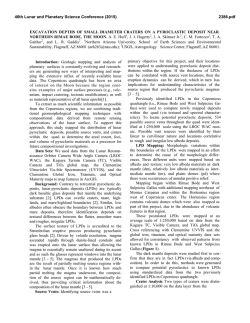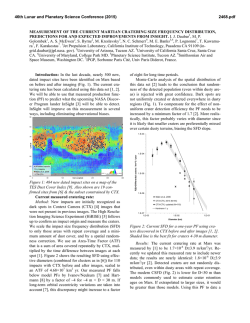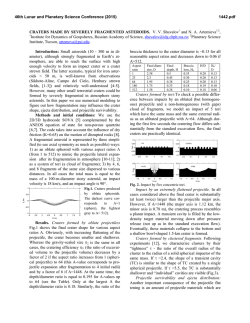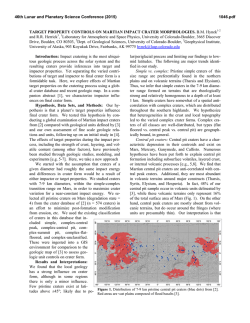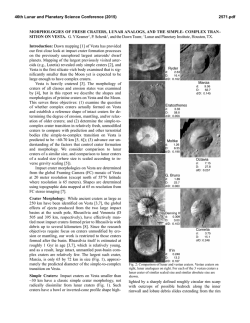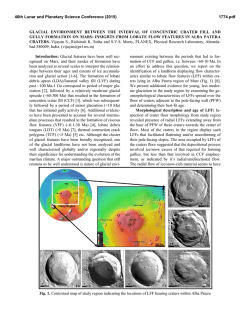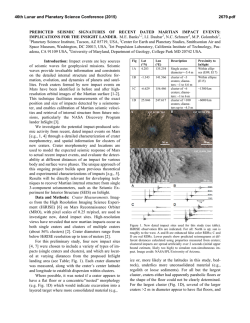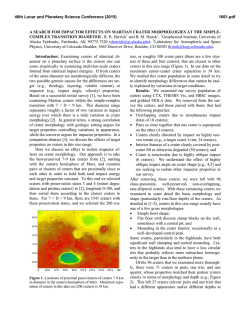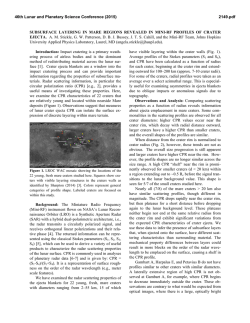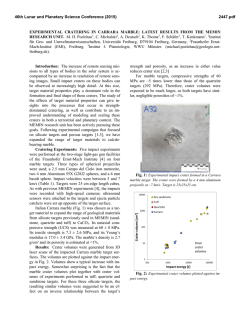
A LARGE SPECTRAL SURVEY OF SMALL LUNAR CRATERS
46th Lunar and Planetary Science Conference (2015) 1655.pdf A LARGE SPECTRAL SURVEY OF SMALL LUNAR CRATERS. P. G.. Lucey,1 J. A. Norman,1 S. T. Crites,1 G. J. Taylor,1 B. R. Hawke,1 M. Lemelin,1 H. J. Melosh2, 1Hawaii Institute of Geophysics and Planetology, University of Hawaii at Manoa, 1680 East West Road, Honolulu, Hawaii 96822, U.S.A ([email protected]).. 2 Department of Earth, Atmospheric, and Planetary Sciences, Purdue University, West Lafayette, Indiana, 47907. Introduction: One of the more intriguing observations in lunar remote sensing was made by Pieters 1986 [1] who noted a significant difference between the noritic composition of the uppermost crust inferred from spectra of small craters, and diverse mineral assemblages observed in central peaks. Pieters indicated that it seemed not possible to arrive at the noritic composition by mixing the observed deeper compositions revealed in central peaks and proposed several hypotheses to account for the observations. These included compositional gradients imposed on the crust during magma ocean crystallization, post-magma ocean igneous intrusions into the crust, or deposition on the surface of material deeply excavated by major impact basins. In [1] the small crater sample comprised craters 5 km or smaller based principally on the spatial resolution limitations of the groundbased spectroscopic technique then available. With the abundant new spectral data now available we can expand the sample of small craters to all longitudes, and include smaller craters. Pieters acknowledged that her inclusions were based on a relatively small sample; expanding that sample is the goal of this paper. We present the results of spectral analysis of about 2700 lunar highland craters occurring at latitudes within 50 degrees of the equator and at all longitudes. We analyze these data with an empirical comparison of the spectra of the craters with the well-documented spectral and compositional data of the Lunar Soils Characterization Consortium (LSCC) data [2,3] and with radiative transfer mixing models. We place these results into context using models of basin excavation and basin melt formation to test the hypothesis that the materials of this crater population represent basin ejecta or basin impact melt. DATA: Visible and near-infrared spectra from the Japanese Space Agency (JAXA) SELENE (Kaguya) Spectral Profiler (SP) were used for the survey. SP obtained a global sample of spectra of the lunar surface at a resolution of ∼550 m from 0.5 to 2.4 µm in the form of single pixel, largely nadir profiles along the track of the polar orbit of the SELENE satellite ([4,5,6]. During the course of the SELENE mission the orientation of the plane of the satellite orbit with respect to the Moon-sun line—the β angle—varied widely so optimal lighting conditions where the solar incidence angle is at a minimum occur only in portions of the data. Numbered by orbit (“revolution” in JAXA’s terminology), revolutions between 4000 and 5000 were particularly well-illuminated so this survey used that range of data. Of the 1000 orbits in this range, 467 were used for the survey comprising approximately five million spectra. The data were photometrically corrected using the equations of [7] using the “highland” photometric parameters. To detect the desired craters for this survey, the first criterion was to cull out mature locations from the data. The space weathering parameter OMAT [8] was computed from the data using the constants provided in that paper, and a cutoff of 0.25 was applied to the data to isolate candidate immature locations. OMAT includes apparent reflectance as an input parameter and so is sensitive to variations in that quantity due to topographic shading. To minimize that effect and also to maximize signal-to-noise ratio, analysis was also confined to latitudes within 50 degrees of the equator. This culling resulted in a total of 37870 candidate spectra with high-OMAT values indicating likely immature locations. Because mass wasting and large recent craters can produce fresh surfaces not associated with small craters, and the remaining topographic shading can cause OMAT artifacts on sun-facing slopes, each candidate location was visually inspected using Kaguya Multiband Imager (MI) data and classified as a small crater, large crater or other geologic feature. This resulted in identification of 4506 individual immature craters <1 km in diameter. For many of these craters more than one SP spectrum occurs within one crater radius from the rim so the entire data set comprises 8184 individual spectral measurements. Results: The small crater spectral properties fall into three distinct groups correlating with geologic units: mare craters; craters withn the feldspathic highlands terrane (FHT); and craters with the South PoleAitken Basin (SPA) and near Apollo 14. Mare craters are characterized as expected by strong mafic bands due to pyroxene, with band centers near 0.97 microns indicating dominance of the mafic assemblage by highCa pyroxene. The spectral properties of the small craters within the FHT are extremely uniform, with relatively weak bands and featuring an average band minimum near 0.905 microns, with a one-sigma variation of 0.02 microns. Craters within SPA and near Apollo 14 show stronger bands than those of FHT, but are still 46th Lunar and Planetary Science Conference (2015) uniform, with band minima near 0.92 microns with a one-sigma variation of 0.02 microns. Spectra were analyzed for pyroxene chemistry using an empirical calibration based on the data of the LSCC [2.3]. This shows the FHT is extremely noritic, with a ratio of low-Ca pyroxene to high-Ca pyroxene of 0.99 +/- .01. Craters within SPA contain small amounts of high-Ca pyroxene with a ratio of low-Ca pyroxene to high-Ca pyroxene of 0.88 +/- .07. Modal mineralogy was derived using a radiative transfer model validated with the LSCC data. This analysis shows the small craters within SPA are anorthositic norite using the nomenclature of [9], while those within SPA fall within the norite field. Discussion: The extensive sampling here underscores and strengthens the observations made by Pieters (1986). The spectral character of the small crater population of the FHT, away from SPA, Imbrium and cryptomaria is exclusively noritic in the strict sense, with no evidence for significant high-Ca pyroxene. The absorption band minima exhibited by these spectra are uniformly at very short wavelengths indicating that this material contains only orthopyroxene as a mafic phase. The FHT composition can be modeled as mechanical mixing and emplacement of ejecta composed of pure anorthosite crust with an underlying orthopyroxenite mantle. We modeled 43 impact basins with the Moon as a shell of pure orthopyroxenite mantle, overlain by a shell of anorthosite, in this case 2% orthopyroxene and 98% plagioclase. Varying depth diameter ratio and crustal thickness allows us to arrive at an average basin ejecta composition matching that of the FHT. Two crustal thicknesses were used, 34 and 43 km from the average crustal thickness estimates of [10] and these gave rise to basin depth diameter ratios of 0.059 and 0.074 to match the observed composition of the FHT. The problem posed by Pieters (1986) was that the composition of the materials excavated by central peaks, presumably representing a large section of the crust, is not similar to the noritic composition revealed by the small crater population. The work reported here confirms that observation by showing the apparent compositional difference between the two populations (central peaks of large craters and deposits of small craters) is not an artifact of poor sampling of the small crater population. This apparent conflict is resolved by recognizing that mantle must comprise a large fraction of basin ejecta (as shown by previous work and modeling done above), and that its ultramafic composition will cause it to dominate the mafic composition of a mixture of anorthositic crust and ultramafic mantle. The extreme noritic nature of the small crater popula- 1655.pdf tion requires that mantle composition incorporated into basin ejecta must be largely orthopyroxenite. FHT SPA Rock Type (Stoffler) Noritic Anorthosite Norite Plagioclase 80.4% 56.4% Pyroxene 19.6% 41.6% Olivine 0.03%* 1.9%* Low Ca Pyroxene/Total Pyroxene 0.99 +/- .05 0.88 +/- .07 References: [1] Pieters, C.M. (1986) Reviews of Geophysics and Space Physics, 24, 557–578. [2] Taylor, L.A., Pieters, C.M., Keller, L.P., Morris, R.V., and McKay, D.S. (2001) JGR, 106, 27985–27999, doi:10.1029/ 2000JE001402. [3] Taylor, L.A., Pieters, C., Patchen, A., Taylor, D.-H.S., Morris, R.V., Keller, L.P., and McKay, D. S. (2010) JGR, 115, E02002, doi:10.1029/2009JE003427. [4] Haruyama, J., Matsunaga, T., Ohtake, M., Morota, T., Honda, C., Yokota, Y., Torii, M., Ogawa, Y., and the LISM Working Group (2008) Earth Planets Space, 60, 243–255. [5] Matsunaga, T., Ohtake, M., Haruyama, J., Ogawa, Y., Nakamura, R., Yokota, Y., Morota, T., Honda, C., Torii, M., Abe, M., Nimura, T., Hiroi, T., Arai, T., Saiki, K., Takeda, H., Hirata, N., Kodama, S., Sugihara, T., Demura, H., Asada, N., Terazono, J., and Otake, H. (2008). GRL , 35, L23201. [6] Y Satoru Yamamoto, S., R. Nakamura, T. Matsunaga, Y. Ogawa, Y. Ishihara, T. Morota, N Hirata, M. Ohtake, T. Hiroi, Y. Yokota, and J. Haruyama (2010) Nature Geoscience, 3, 533–536. http://dx.doi.org/10.1038/ ngeo897.[7] Yokota, Y., Matsunaga, T., Ohtake, M., Haruyama, J., Nakamura, R., Yamamoto, S., Ogawa, Y., Morota, T., Honda, K., Saiki, C., Nagasawa, K., Kitazato, K., Sasaki, S., Iwasaki, A., Demura, H., Hirata, N., Hiroi, T., Honda, R., Iijima, Y., and Mizutani, H. (2011) Icarus, vol. 215, pp 639–660, ISSN 0019-1035, http://dx.doi.org/10.1016/j.icarus.2011.07.028. [8] Lucey, P.G., Blewett, D.T., Taylor, G.J., and Hawke, B.R. (2000) JGR, 105, E, 8, 20297–20305. [9] Stoffler, D., Knoll, H.-D., Marvin, U.B., Simonds, C.H., and Warren, P.H. (1980) In J.J. Papike and R.B. Merrill, Eds., Proceedings of the Conference on the Lunar Highland Crust, p 51–70. Pergamon Press. [10] Wieczorek, M.A. et al. (2013) Science, 339, 671-675, doi: 10.1126/science.1231530. Acknowledgments: This work was supported in part by the NASA LASER Program, grant NNX12AI78G, P.G. Lucey, PI.
© Copyright 2026

